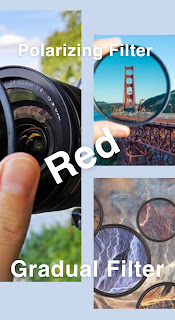Filters
Filters
Filters are made up of high quality glass and are typically attached to the from of the camera lens. These filters are used to clock certain colours or light sources from coming into the camera. Nd Filters particularly are designed to reduce the overall light intensity from coming into the camera. Teases filters usually screw on on or slot into place depending on the lens and camera being used.
Polarising Filter
These filters have the ability to change transmitting light that vibrates in one direction whilst absorbing light that vibrates in a perpendicular fashion. This is what is used in the likes of sunglasses. When these are places over a camera lens it reduces unwanted reflections in your image.
what does Polarising do?
Polarising is done by attaching a polarising filter to your camera lens, These can be used to minimise reflections, reduce glare, add contrast to images and to darken the sky. Using a lens is much better than trying to achieve the same look in post production. There are no tools yet available to reduce glare and refection on an image.
Red Contrast Filter
Sometimes when we change an image to grey scale, colours such as green red and blue can blend therefore gives us less contrast on an image. In order to enhance the contrast we can use a red filter. This will allow red light through but will block green and blue. Any red that is in the image will then appear brighter and more contrasted compare to the other colours which will remain dark. The red filter is often considered too harsh for most types of photography but is widely used in order to give a creative effect. A blue sky in an image using a red filter will turn the sky black thus allowing the whites of the clouds to stand out. Red filter are often used in poor conditions such as fog.
UV Filter
This lens reduces the amount of ultra violet light that passes into the camera. This is the most common type of filter and is generally used to protect the camera lens more than anything. It shields the front element of the lens from dust and other degree and is important when shooting outdoors. In all this filter removes the UV rays from the sun creating clearer image.




Comments
Post a Comment